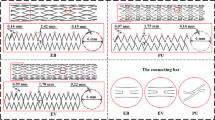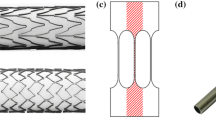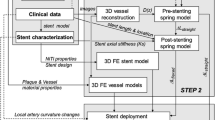Abstract
In order to study the influence of different vascular stenosis rates and stent-to-artery ratios on the fatigue strength and reliability of lower limb arterial stents, numerical simulation was conducted for the fatigue strength of complete SE stents under pulsating loads using a finite element method. Then, fracture mechanics and conditional probability theory were adopted for mathematical modeling, whereby analyzing the crack growth rate and reliability with stents of different thickness (0.12, 0.15, and 0.18 mm) at different vascular stenosis rates (30, 50, and 70%) and stent-to-artery ratios (80, 85, and 90%). The study found: all three stents of different thickness failed to meet 10-year service life at three vascular stenosis rates; all three stents of different thickness met 10-year service life at three stent-to-artery ratios. With increased vascular stenosis rate, the elastic strain of stents was increased, while the fatigue strength was decreased; with increased stent-to-artery ratio, the elastic strain of the stent was increased, while the reliability of the stent was reduced. After the stent with an initial crack was implanted into the vessel, the crack length underwent non-linear growth with increased pulsating cyclic loads. When the pulsating load reached 3 × 108, the growth rate of the crack on the stent surface increased exponentially, leading to a rapid decrease in reliability. Vascular stenosis rate, stent release ratio, and support thickness have significant effects on crack length propagation rate and reliability. Determining the influence of vascular stenosis rate and stent-to-artery ratio on the fatigue strength and reliability of stents provides a valuable reference for evaluating the fracture failure rate and safety of stents.








Similar content being viewed by others
References
Beebe, H. G. Lessons learned from aortic aneurysm stent graft failure: observations from several perspectives. Semin. Vasc. Surg. 16:129–138, 2003.
Bernini, M., M. Colombo, and C. Dunlop. Oversizing of self-expanding nitinol vascular stents—a biomechanical investigation in the superficial femoral artery. J. Mech. Behav. Biomed. Mater.132:105259, 2022.
Cardini, F., E. Zio, and D. Avram. Model-based Monte Carlo state estimation for condition-based component replacement. Reliab. Eng. Syst. Saf. 94:752–758, 2009.
Cunnane, E. M., J. J. Mulvihill, H. E. Barrett, et al. Mechanical, biological and structural characterization of human atherosclerotic femoral plaque tissue. Acta Biomater. 11:295–303, 2015.
Daly, S., A. Miller, G. Ravichandran, and K. Bhattacharya. An experimental investigation of crack initiation in thin sheets of nitinol. Acta Mater. 55:6322–30, 2007.
De Bock, S., F. Iannaccone, G. De Santis, et al. Virtual evaluation of stent graft deployment: a validated modeling and simulation study. J. Mech. Behav. Biomed. Mater. 13:129–139, 2012.
Duerig, T. W., A. R. Pelton, and D. Stockel. An overview of nitinol medical applications. Mater. Sci. Eng. A. 273:149–160, 1999.
Feng, H. Q., Z. Y. Hu, X. D. Jiang, et al. Research on elastic and plastic deformation of CoCr alloy used for coronary stents. J. Plast. Eng. 19:108–112, 2012.
Gasser, T. C., R. W. Ogden, and G. A. Holzapfel. Hyperelastic modelling of arterial layers with distributed collagen fibre orientations. J. R. Soc. Interface. 3:15–35, 2006.
Gökgöl, C., N. Diehm, and P. Büchler. Numerical modeling of nitinol stent oversizing in arteries with clinically relevant levels of peripheral arterial disease: the influence of plaque type on the outcomes of endovascular therapy. Ann. Biomed. Eng. 56:1420–1433, 2017.
Gökgöl, C., N. Diehm, F. R. Nezami, et al. Nitinol stent oversizing in patients undergoing popliteal artery revascularization: a finite element study. Ann. Biomed. Eng. 43:2868–2880, 2015.
He, R., L. G. Zhao, and V. V. Silberschmidt. A computational study of fatigue resistance of nitinol stents subjected to walk-induced femoropopliteal artery motion. J. Biomech.118:110295, 2021.
Holzapfel, G. A., M. Stadler, and C. A. J. Schulze-Bauer. A layer-specific three-dimensional model for the simulation of balloon angioplasty using magnetic resonance imaging and mechanical testing. Ann. Biomed. Eng. 30:753–767, 2002.
Jimenez-Navarro, M. F., F. Lopez-Jimenez, G. Barsness, et al. Long-term prognosis of complete percutaneous coronary revascularisation in patients with diabetes with multivessel disease. Heart. 101:1233–1239, 2015.
Keedy, E., and Q. Feng. A physics-of-failure based reliability and maintenance modeling framework for stent deployment and operation. Reliab. Eng. Syst. Saf. 103:94–101, 2012.
Lei, L., X. Qi, S. Li, et al. Finite element analysis for fatigue behaviour of a self-expanding nitinol peripheral stent under physiological biomechanical conditions. Comput. Biol. Med. 104:205–214, 2019.
Li, Z., H. Feng, and W. Yan. Fatigue strength of intracranial artery stents. J. Med. Biomech. 33:442–446, 2018.
Marines-Garcia, I., P. C. Paris, H. Tada, and C. Bathias. Fatigue crack growth from small to long cracks in very-high-cycle fatigue with surface and internal “fish-eye” failures for ferrite-perlitic low carbon steel SAE 8620. Mater. Sci. Eng. A. 468:120–128, 2007.
Marrey, R., R. Burgermeister, and R. O. Grishaber. Fatigue and life prediction for cobalt-chromium stents: a fracture mechanics analysis. Biomaterials. 27:1988–2000, 2006.
Martin, D., and F. Boyle. Finite element analysis of balloon-expandable coronary stent deployment: influence of angioplasty balloon configuration. Int. J. Numer. Method Biomed. Eng. 29:1161–1175, 2013.
Members, W. G., D. Mozaffarian, E. J. Benjamin, et al. Executive summary: heart disease and stroke statistics—2016 update: a report from the American Heart Association. Circulation. 127:143–152, 2016.
Morlacchi, S., G. Pennati, L. Petrini, et al. Influence of plaque calcifications on coronary stent fracture: a numerical fatigue life analysis including cardiac wall movement. J. Biomech. 47:899–907, 2014.
Pelton, A., X. Gong, and T. Duerig. Fatigue testing of diamond-shaped specimens. Med. Devices Mater. 2:199–204, 2003.
Peng, H., Q. Feng, and D. W. Coit. Reliability modeling for MEMS devices subjected to multiple dependent competing failure processes. Proc. Ind. Eng. Res. Conf. 64:932–948, 2012.
Riepe, G., C. Heintz, E. Kaiser, et al. What can we learn from explanted endovascular devices. Eur. J. Vasc. Endovasc. Surg. 24:117–122, 2002.
Robertson, S. W., and R. O. Ritchie. In vitro fatigue–crack growth and fracture toughness behavior of thin-walled superelastic nitinol tube for endovascular stents: a basis for defining the effect of crack-like defects. Biomaterials. 28:700–709, 2007.
Robertson, S. W., and R. O. Ritchie. A fracture-mechanics-based approach to fracture control in biomedical devices manufactured from superelastic nitinol tube. J. Biomed. Mater. Res. B. 84:26–33, 2007.
Sachs, N. W. Understanding the surface features of fatigue fractures: how they describe the failure cause and the failure history. J. Fail. Anal. Prev. 5:11–15, 2005.
Shishehbor, M. H., and M. R. Jaff. Percutaneous therapies for peripheral artery disease. Circulation. 134:2008–2027, 2016.
Song, J. Research on the Expansion and Fatigue Properties of Medical Stents in Narrow Tapered Blood Vessels. Zhenjiang: Jiangsu University, 2018.
Stents, I., and H. Services. Guidance for Industry an FDA Staff Non-Clinical Engineering Tests and Recommended Labeling for Intravascular Stentsand Associated Delivery Systems, 2010.
Wang, J. Research on Prediction of Ultra-high Cycle Fatigue Life and the Judgment of Re-manufacturability of Blade Material FV520B-1 Based on Fatigue Damage. Dalian: Dalian University of Technology, 2019.
Wang, Y., and H. Pham. Imperfect preventive maintenance policies for two-process cumulative damage model of degradation and random shocks. Int. J. Syst. Assur. Eng. Manag. 2:66–77, 2011.
Xu, J. Research on the Mechanical Mechanism of Coronary Stent Fracture. Chengdu: Southwest Jiaotong University, 2018.
Acknowledgments
The work was supported by the National Natural Science Foundation of China (12162026), by the Inner Mongolia Science and Technology Plan Project (2020GG0024), and the Natural Science Foundation of Inner Mongolia (2021LHMS05001).
Conflict of interest
The authors declare that there is no potential conflict of interest with respect to the research, authorship, and/or publication of this article.
Author information
Authors and Affiliations
Corresponding authors
Additional information
Associate Editor Stefan M. Duma oversaw the review of this article.
Publisher's Note
Springer Nature remains neutral with regard to jurisdictional claims in published maps and institutional affiliations.
Rights and permissions
Springer Nature or its licensor (e.g. a society or other partner) holds exclusive rights to this article under a publishing agreement with the author(s) or other rightsholder(s); author self-archiving of the accepted manuscript version of this article is solely governed by the terms of such publishing agreement and applicable law.
About this article
Cite this article
Ma, S., Feng, H., Feng, H. et al. Analysis of Fatigue Strength and Reliability of Lower Limb Arterial Stent at Different Vascular Stenosis Rates and Stent-to-Artery Ratios. Ann Biomed Eng 51, 1136–1146 (2023). https://doi.org/10.1007/s10439-023-03165-6
Received:
Accepted:
Published:
Issue Date:
DOI: https://doi.org/10.1007/s10439-023-03165-6




